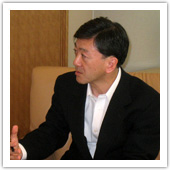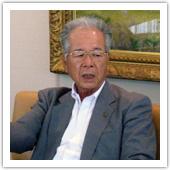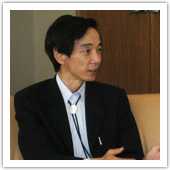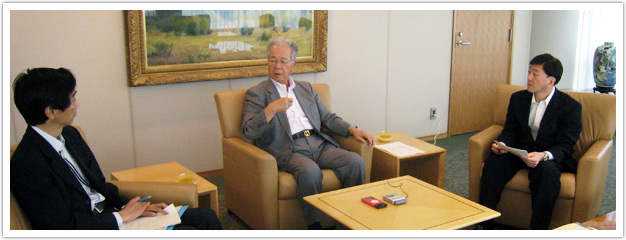RIETI held a series of roundtable discussions in May and June, each time inviting a business leader with proven expertise for discussion with RIETI Chairman Atsushi Nakajima and a RIETI researcher on post-disaster reconstruction and challenges ahead.
Takeo Higuchi, Chairman and CEO of Daiwa House Industry joined RIETI Chairman Atsushi Nakajima and RIETI Vice Chairman and Vice President Masayuki Morikawa for our second roundtable discussion.
 Atsushi Nakajima (RIETI Chairman):
Atsushi Nakajima (RIETI Chairman):
The Great East Japan Earthquake destroyed or damaged huge numbers of homes, and although temporary housing is currently under construction, it seems to be proving difficult in some areas.
Preventing a "fourth disaster" (the disappearance of industry) with a vision for the construction of comfortable towns with a total of 1.5 million homes
 Takeo Higuchi (Chairman and CEO of Daiwa House Industry):
Takeo Higuchi (Chairman and CEO of Daiwa House Industry):
Following the disaster, the Japan Federation of Housing Organizations (Judanren) set up an emergency task force at the request of the Ministry of Land, Infrastructure, Transport and Tourism, and through this task force we began supplying temporary and emergency housing. Construction of this housing, however, is proving quite difficult; temporary and emergency housing has been built in extensive areas across three prefectures, and there is hardly any flat land available in these prefectures.
Construction personnel numbering some 1,500-2,000 from all over the country have gone to Tohoku, where they are bussed for one and a half to two hours to their work sites from their base at a hotel in the town of Zao in Miyagi Prefecture. I think all the companies operating there are facing difficulties. The hardest thing for us, though, was deciding where to build the temporary housing. It was a difficult decision to make, and proved to be the biggest stumbling block.
There have also been problems obtaining construction materials, with insulating material and plywood, for example, cited as having been in short supply. All the companies have recognized that the nation's survival is at stake, and the materials departments of each of them have done their best to secure supplies. As a result of their efforts, we have been able to obtain more or less the quantities of materials we originally expected. The initial plan called for Judanren to build 62,000 temporary homes. In the end, however, only 41,000 units were needed.
Subprefectural governments (cities, towns, and villages) decide where they will be built, and once the locations are determined, the prefectural governments give us the green light to begin construction. In other words, it is the subprefectural governments that initially gauge how the disaster victims really feel and what they want done.
A key task to begin with is to find out whether temporary housing has already been built in places where victims of the disaster wish to live. However, even if a location that a victim likes has temporary housing available, the victim has to bear the cost of things like utilities and food if they move in. Many people don't have the money so can't move in even if they want to. That's kind of where we are with things now.
Nakajima:
So the situation is different from that following the Great Hanshin-Awaji (Kobe) Earthquake.
Higuchi:
The Great Hanshin-Awaji Earthquake only affected a single area. Many of the victims worked at companies, and a lot of the people they knew around them had not been affected. This time, however, a huge number of victims are farmers or fishermen. Many of the fishermen, for example, had fathers and grandfathers who were also fishermen. They've been fishing ever since they were children, and they can't move away because fishing is the only work they know how to do.
The Sanriku Coast was hit by a large tsunami during the Meiji Period, and a monument stands there saying that houses should not be built before it. The recent tsunami also came in just as far as this monument, and the houses built before it were all swept away.
Iwate and Miyagi prefectures suffered a great deal of damage from the earthquake and tsunami, while Fukushima has been afflicted by the radioactive contamination. I describe the earthquake as the first disaster, the tsunami as the second, and the radiation leaks as the third. It is more important than anything else right now to prevent a fourth disaster. A fourth disaster would be marked by an even graver economic situation caused by a loss of industry due to problems at the nuclear power plant, which have led to a shortage of electric power and the spread of harmful rumors concerning radioactive contamination.
Nakajima:
Demand for housing was brisk for around a year after the Great Hanshin-Awaji Earthquake. However, if things continue like this, there is a risk that even a recovery in investment in housing construction could be delayed.
Higuchi:
I think there is a real danger of that happening. Fishermen cannot leave the fishing industry, and farmers cannot leave agriculture. I therefore believe that the national government should purchase all the affected land and build towns that can offer residents dreams and hopes for the future. It could take five years to implement land and housing reconstruction plans, so I think a clear vision needs to be set out in order to persuade the residents to wait for such a period of time.
Specifically, I think a vast housing development comprising 1.5 million homes and based on the concepts of smart houses and smart grids should be created. People from the same communities would all be housed in the same development. Snowy areas would have high-rise apartment buildings so that residents no longer need to clear snow from around their homes. The development would contain schools, hospitals, and shopping malls. There would be private retirement homes and both daytime services and daycare centers for the elderly. There would be no overhead power lines and the towns would be rich in greenery. And as the years passed, land values in the towns would rise.
A plan like this should be carefully crafted, and the public should be convinced of its merit as a solution. Disaster victims need to be given a dream. I think it would be tough to give them real optimism by just telling them to keep their chin ups and carry on battling.
Rebuilding Japan is mainly an administrative policy and political issue
Nakajima:
As you say, in Tohoku the proportion of people working in primary industries is high, and employment opportunities are limited. On the other hand, the real-estate bubble is long over and for the last ten years public spending on infrastructure projects has been curtailed. As a result, Japan as a whole, including Tohoku, has spare construction capacity, so now could be the time to take on the challenge of building new districts and new towns.
Higuchi:
I believe that now is a time for change. There have been proposals to plant a forest for the repose of the souls of the dead, and hold a ceremony to get a sense of closure with the disaster and allow them to be at peace.
Areas at risk of tsunami inundation in the future should be turned into something along the lines of national parks, i.e. made into areas rich in greenery. Quays should also be reconstructed to allow fishing to be resumed. Huge housing developments should be built on higher ground, and such areas should be built in both Miyagi and Iwate prefectures.
The situation with Fukushima, though, is different. The fourth disaster that I am concerned about would be marked by an economic recession in Japan, and this must not be allowed to occur. If it does, it will make recovery impossible. Japan, which has achieved economic development by demanding strength in exports, would lose its competitive edge in the export field. The disappearance of industry would also be a concern.
 Masayuki Morikawa (RIETI Vice Chairman and Vice President):
Masayuki Morikawa (RIETI Vice Chairman and Vice President):
The subject of smart houses and smart grids came up earlier in the discussion. However, according to domestic and international research focusing on the manufacturing industry, a twofold increase in the population density of a city boosts productivity by around 3% to 8%. Moreover, an analysis I conducted for RIETI revealed that the productivity gain to the service sector would be roughly 15%. This analysis also found that energy efficiency also improves with higher population density. If the population density of a city doubles, energy efficiency at business facilities increases by approximately 12%.
I therefore feel that a key challenge for Japan, with its declining population, is to move forward with the construction of compact cities. I believe that implementing policies, including as part of the post-disaster reconstruction effort, to make the population more geographically concentrated will be extremely important for the reconstruction of Tohoku.
Higuchi:
Such policies must not be handed down from above. A proper consensus will need to be obtained from the victims of the disaster. It is not enough to just build temporary housing. Subprefectural governments, prefectural governments, and the national government should work together beforehand to properly coordinate financial support for those who move in. I believe the issue of Japan's reconstruction will have a lot to do with government policy and the world of politics.
Building earthquake-resistant and energy-efficient housing as property and social infrastructure and not as consumer goods, will underpin safety and economic prosperity
Nakajima:
The construction of disaster-resistant towns and energy-efficient housing, to support the establishment of a next-generation economy and next-generation industry, will be an essential means of using recovery from the disaster as a springboard for making Japanese industry more competitive.
Higuchi:
Before becoming Chairman of Judanren, I served for five years as Chairman of the Japan Prefabricated Construction and Suppliers & Manufacturers Association, and we supplied emergency temporary housing on five occasions during that five-year period. I traveled to the sites of all the disasters, such as the Noto Earthquake and the Chuetsu Earthquake, and it was clear that the houses in these areas had not been adequately reinforced against earthquakes. We therefore issued a proposal for the national government to order prefectural and subprefectural governments to improve houses with inadequate earthquake resistance over the next three years. More effort is needed to ensure the safety, peace of mind, and lives of the people.
In the wake of the recent disaster, what ordinary consumers who are thinking of building a house are especially interested in is earthquake resistance and energy efficiency. Manufacturers will therefore have to work hard on developing products while keeping costs to a minimum. They also need to make houses that can be lived in for 100 or 200 years. Promoting the rethinking of houses as social infrastructure, not consumer goods, will ensure safety and peace of mind and also support the economy.
Morikawa:
A great deal of empirical research is being conducted on energy-efficient housing. Research performed in the U.S., for example, has found that when electricity charges increase, people want to construct more energy-efficient houses, and if electricity prices double, homes that are around 20 percent more energy efficient are constructed. And these energy savings continue for several decades.
The impact of a rise in the cost of electricity on the competitiveness of industry can be expected to depend on the ability of consumers to cut their power usage.
Higuchi:
People talk about homes that generate energy, save energy, and store energy. Generating energy refers to creating clean energy from sources such as the sun and the wind, saving energy is about building well-insulated homes, and storing energy refers to the lithium ion battery technology that our company has been working on developing. I think that all this needs to be done on a larger scale.
Although moves are under way in countries like Spain and Germany to do away with nuclear power altogether, France generates 80% of its electricity this way. President Sarkozy has therefore pledged to ensure safety by making nuclear power stations resilient to any natural disaster whatsoever, and to build a business by exporting the technology involved.
The Japanese tend to go from one extreme to another. In the past, when they believed that land was a good investment, Japan turned into a nation of 100 million real-estate speculators. Land values shot up, but then plunged just as rapidly. And now that everyone thinks land is a bad investment, land values are low across the board.
Things shouldn't be thought about in such extreme turns. Rigorous safety standards should be decided on, and then calmly implemented. For example, nuclear power plants in places that can be protected from natural disasters should be left standing, provided they can be made safer, although I believe that such decisions should be made following discussions among specialists.
I also want politicians to gain the understanding of the public by stating clearly that this approach is going to be applied to make Japan a more prosperous and safer place, a place in which people can live with greater peace of mind. Overseas, the people in the disaster zone have received a lot of praise for their patience and commitment to cooperation. So why is it that the government is not receiving more praise?

The national government should set out a master plan for restoration and innovation and implement it in such a way as to give the people dreams
Nakajima:
We should take the lead in developing new homes that generate, save, and store energy, and help create new lifestyles. If Japan can deliver these innovations first, they will become a source of competitive strength and can be exported to the rest of the world.
Higuchi:
In Germany, however, Chancellor Merkel is pledging to decommission all the country's nuclear power plants by 2022. The generation of clean forms of energy is to be increased to make up the difference but, at present, lithium ion batteries are the only method of storing surplus energy.
Our company is working on the development of safer lithium ion batteries, and blue-chip corporations from around the world have come to observe what we are doing and requested us to work together with them in this area. Working together is all very well, but it will not involve the sale of the technology.
Our investment in technology such as lithium ion batteries and robotic suits and in new business fields such as the industrialization of agriculture follows the teachings of our founder. He would say, "Mr. Higuchi, you need to pursue various different businesses if you are to make the company bigger, but you mustn't think in terms of what will make money. You should make products that are useful to a great many people and products that bring delight to the people of the world, and you should leave those businesses behind as your legacy." I think that this way of thinking constitutes the Daiwa House DNA.
Nakajima:
So the reconstruction of Tohoku, the corporate management perspective, and the revitalization of the Japanese economy depend on how to get the people actually there to feel excitement.
Higuchi:
Yes, I think so. I also want politicians to ensure that an economic slump on the scale of a "fourth disaster" does not occur and that industry does not disappear. I believe that everyone involved in industry feels the same way.
Morikawa:
Earlier on I talked about building new towns over a five-year period, and I think that this will require some easing of regulations concerning land use.
Higuchi:
I think that special zones will need to be established for that purpose. It normally takes six months to a year, or two years to get permission to build and assess the environmental impact. So, looser rules applied to special zones should be advantageous to the disaster areas. As soon as the locations are determined, construction can be completed quickly.
Nevertheless, new cities need to be created that fully reflect the wishes of the people in the disaster zone. They shouldn't just be urged to "do their best." The national government should take responsibility and offer a detailed master plan. That way, the local people can be given a dream, a vision of their future living environment. I think human beings are pretty simple creatures, because their expressions change depending on whether they are motivated or not. As such, having a dream is incredibly important.
Nakajima:
Thank you for sharing your thoughts with us.
Everyone:
Thank you.

